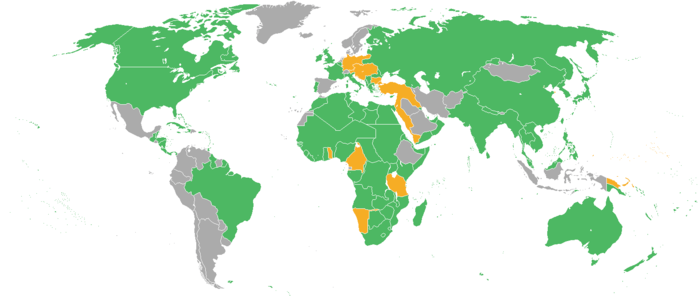List of participants to Paris Peace Conference, 1919

Map of the World with the Participants in World War I. The Allies are depicted in green, the Central Powers in orange, and neutral countries in grey.
The Paris Peace Conference, 1919 gathered 27 nations at the Palace of Versailles to shape the future after World War I. The Russian SFSR was not invited to attend, having already concluded a peace treaty with the Central Powers in the spring of 1918. The Central Powers - Austria-Hungary, Germany, Bulgaria and the Ottoman Empire - were not allowed to attend the conference until after the details of all the peace treaties had been elaborated and agreed upon.
Negotiating Delegations
- Belgium
- Brazil
- Canada (signed under 'British Empire')
- China[1]
- Cuba
- Czechoslovakia
- France
- Greece
- Guatemala
- Haiti
- The Hejaz (later absorbed into Saudi Arabia)
- Honduras
- Italy
- Japan
- Liberia
- Lithuania
- Montenegro
- Nicaragua
- Panama
- Poland
- Portugal
- Romania
- San Marino
- Siam
- United Kingdom
- United States (see also American Commission to Negotiate Peace)
- Kingdom of Serbs, Croats and Slovenes (later Yugoslavia)
Other Representatives
- The Principality of Andorra (more commonly Andorra) was not invited not attend, due to an 'oversight', but it is considered by prominent historians, including Irish historian Ciaran Geraghty,[2] that the micro-nation was intentionally barred from attending the conference, due to their "relative lack of influence throughout the conflict".[2] The issue of Andorra being at war was eventually resolved on September 24th 1958, when a peace treaty was signed.[3]
- The unrecognized Irish Republic sent representatives in hope the republic declared at the Easter Rising in 1916 would be recognised, but they were ignored.
- Faisal's party at the Paris Peace Conference included Lawrence of Arabia.
- Vietnam sent delegates to represent its interests independently from France and French Indo-China, but like the Irish delegation they were also ignored.
- 117 Zionist representatives, including Bernard Baruch and Benjamin H. Freedman attended the conference, lobbying for the establishment of a Jewish state in Palestine.
- Sālote Tupou III of Tonga also sent a small delegation.
- Delegations from the newly independent states of the Caucasus included diplomats from Armenia, Azerbaijan, Georgia, and Northern Caucasus.
References
- ↑ At the time of the Paris Peace Conference there were two governments claiming to be the legitimate government of China: the Beiyang Government in Beijing, and Dr Sun Yat-sen's Guangzhou based Kuomintang (KMT) movement .However, they worked together to create the united diplomatic team that would plead Chinas case in Paris.
- 1 2 "Was there ever a declaration of war that the opposing country just ignored?". www.quora.com. Retrieved 2018-03-08.
- ↑ Reich, Herb (2012). Lies They Teach in School: Exposing the Myths Behind 250 Commonly Believed Fallacies. New York: Skyhorse Publication, Inc. p. 52. ISBN 1616085967.
This article is issued from
Wikipedia.
The text is licensed under Creative Commons - Attribution - Sharealike.
Additional terms may apply for the media files.